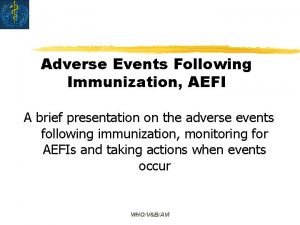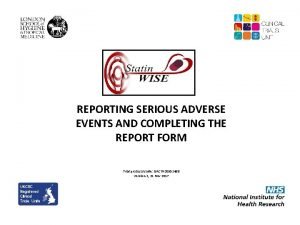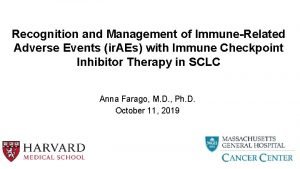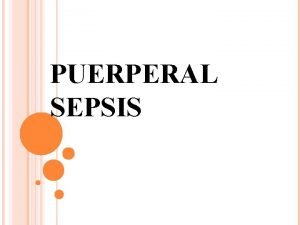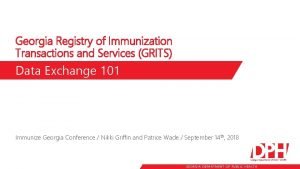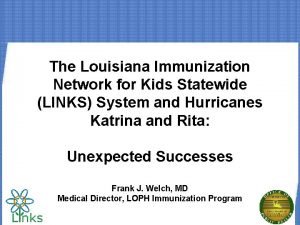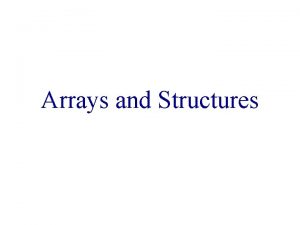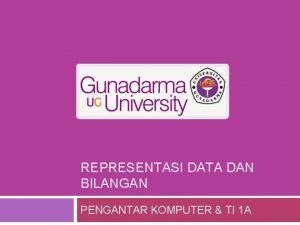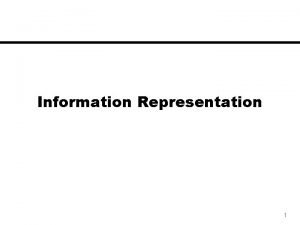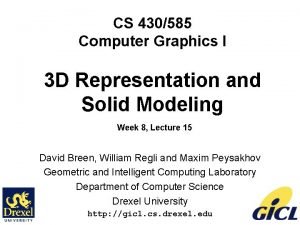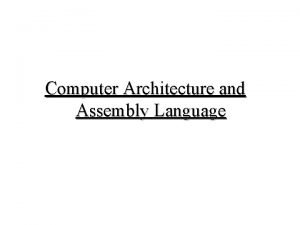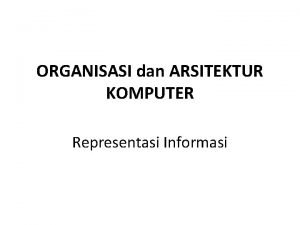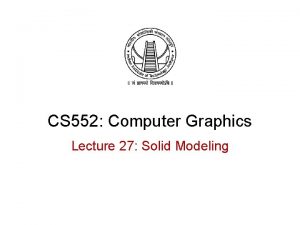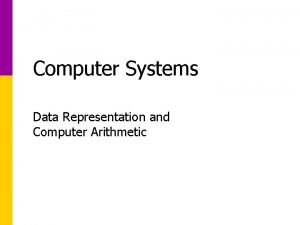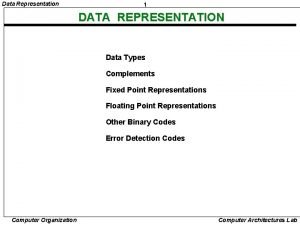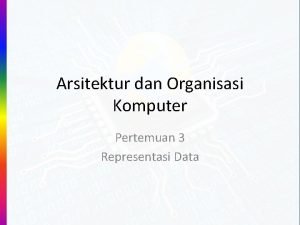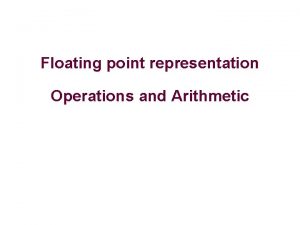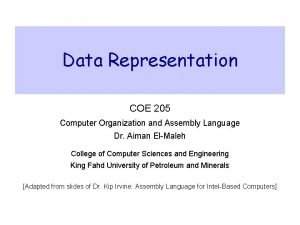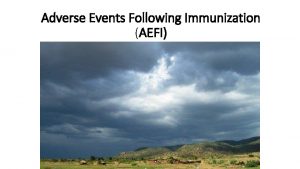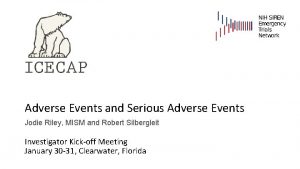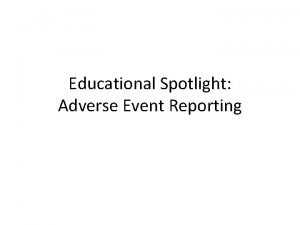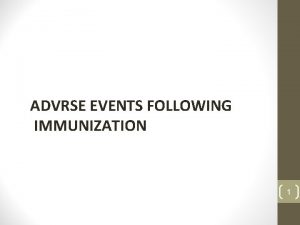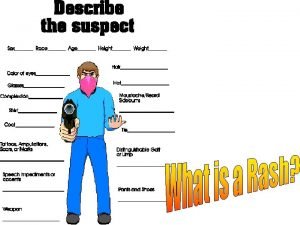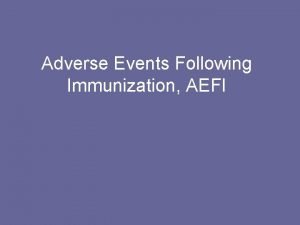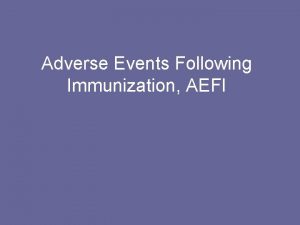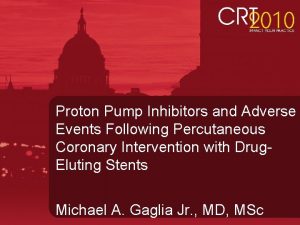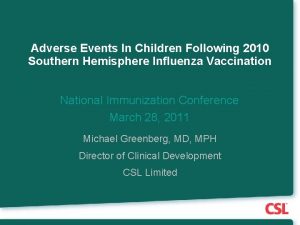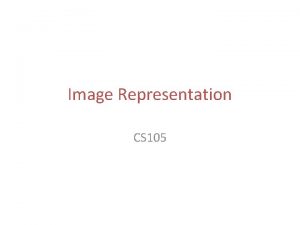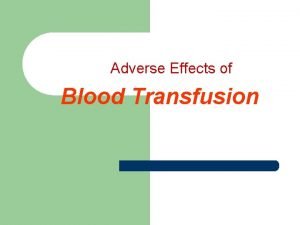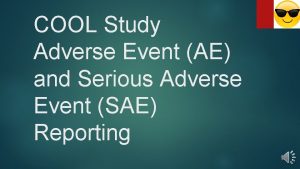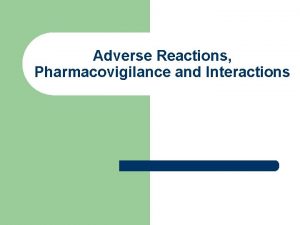Computer Representation of Adverse Events Following Immunizations Using





















- Slides: 21

Computer Representation of Adverse Events Following Immunizations Using Semantic Web Technology Herman Tolentino, MD VAU / BVPDB / ESD / NIP / CDC Public Health Informatics Fellow, PHIFP March 24, 2004

Outline o Introduction o Methods o Results o Conclusion

Semantic Web • A mesh of information • Uses a form of XML called Resource Description Framework (RDF) to store knowledge • Readable by machines • Knowledge is organized as ontologies.

What is an ontology? • A formal, structured conceptualization of a body of knowledge = what we know about something (e. g. , adverse events) • Knowledge base = how we represent the ontology in a system • Our body of knowledge is adverse events following immunization (AEFI)

Seizure Loss of consciousness History Witnessed Manifestations motor manifestations Tonic Clonic Tonic-clonic Level 1 Level 2 Diagnostic certainty

Uses of Ontologies in Public Health • Semantic interoperability • Semantic enhancement • Knowledge repository

Uses of Ontologies in Public Health Semantic Interoperability • Exchange of data at the level of meaning • Semantic problem example: fundus, pyogenic granuloma • Information systems understand each other and allow for flexible retrieval of information

Uses of Ontologies in Public Health Semantic Enhancement • Getting to all possible representations of a controlled vocabulary code • By searching for related concepts in the Unified Medical Language System (UMLS) • Hepatitis - related concepts would be jaundice, icterus, hepatomegaly

Uses of Ontologies in Public Health Knowledge Repository • Knowledge explosion: If a physician reads only 2 journals a day he will be behind by 800 years worth of knowledge at the end of one year (Koop, 1999). • Enabled by rapid advances in and decreasing costs of technology

Adverse Event Ontology Project • OVAE (Ontology for Vaccine Adverse Events) • Problems addressed: • Digitally represent standardized case definitions (semantic interoperability) • Cast a wider net for cases in surveillance systems by getting to related codes using the ontology and UMLS (semantic enhancement) • Knowledge management (repository)

Framework Conceptual Model Case Definitions RDF UMLS RDF Phase I Adverse Events Following Immunization Ontology Phase II User Interface Creation and Inferencing Phase III

Results o Conceptual model of adverse events (BC) o Translation of case definitions and UMLS concepts to Resource Description Framework (RDF) format

1 ADVERSE EVENTS 2 CASE DEFINITIONS 3 CONTROLLED VOCABULARIES 4 CLINICAL MANIFESTATIONS 5 LEVEL OF DIAGNOSTIC CERTAINTY

Seizure Case Definition • Level 1 Diagnostic Certainty • Witnessed sudden loss of consciousness AND • Generalized, tonic, clonic, tonic-clonic, OR atonic motor manifestations • Level 2 Diagnostic Certainty • History of unconsciousness AND • Generalized, tonic, clonic, tonic-clonic, OR atonic motor manifestations

How the UMLS is Used • UMLS concepts are identified using Concept Unique Identifiers (CUIs). • Controlled vocabulary codes are related to concepts. • Using the UMLS and the adverse event ontology, we can semantically enhance event detection by linking concepts in the ontology to concepts in the UMLS.

RDF file of a UMLS table

Seizure Loss of consciousness Concept Unique Identifier (CUI) Manifestations C 000001 Witnessed ICD 9 concepts C 000002 Motor manifestations Tonic Clonic History UMLS Level 1 codes Level 2 ICD 9 Tonic-clonic Diagnostic certainty

Conclusions • The domain of ontology creation is an emerging field in health care. • Advances in technology permit creation of largescale ontologies. • We can use ontologies for semantic interoperability and semantic enhancement and as knowledge repositories. • Collaboration leverages partners’ resources and fosters shared learning.

Future Directions • Phase 1: Continue ontology development • Phase 2: Merge two conceptual domains: vaccine adverse events and UMLS. • Phase 3: Create query interface for inferencing engine.

Acknowledgements • Brighton Collaboration - a voluntary organization of international experts that develops standardized case definitions for AEFI • Office of High Performance Computing and Communications of the National Library of Medicine

Correspondence Herman Tolentino, MD HTolentino@CDC. gov Daniel Payne, MSPH, Ph. D DPayne@CDC. gov BVPDB / ESD / NIP / CDC 1600 Clifton Road NE, Mailstop E-61 Atlanta, GA 30329
 Aefi examples
Aefi examples Adverse events in hospital
Adverse events in hospital Adverse events in hospital
Adverse events in hospital Puerperal sepsis meaning
Puerperal sepsis meaning Georgia registry of immunizations
Georgia registry of immunizations Links louisiana immunizations
Links louisiana immunizations Mutually exclusive vs non mutually exclusive
Mutually exclusive vs non mutually exclusive Polynomial representation using arrays
Polynomial representation using arrays Polynomial division using linked list in c
Polynomial division using linked list in c Data representation computer science
Data representation computer science Data representation in computer organization
Data representation in computer organization Boundary representation in computer graphics
Boundary representation in computer graphics Data representation in computer architecture
Data representation in computer architecture Information representation in computer
Information representation in computer Sweep representation in computer graphics
Sweep representation in computer graphics Data representation and computer arithmetic
Data representation and computer arithmetic Data types and representation
Data types and representation Data representation in computer organization
Data representation in computer organization Float number
Float number Hex code ascii
Hex code ascii Surface representation in computer graphics
Surface representation in computer graphics Adverse reaction definition
Adverse reaction definition
